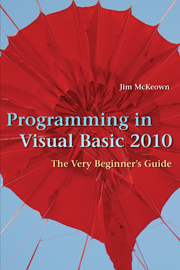Book contents
- Frontmatter
- Contents
- Preface
- 1 Fundamentals of Design and Programming – Starting from Scratch
- 2 Variables and Constants – A Place for Everything and Everything in Its Place
- 3 Writing Programs – First You Walk, Then You Run
- 4 Writing Programs II – More Controls and New Logic
- 5 Using If and Case – Decisions, Decisions, Decisions
- 6 Loops – Once Is Not Enough
- 7 Procedures and Functions – Divide and Conquer
- 8 Writing Programs III – Tying It All Together, So Far
- 9 File I/O – Files and Records and Fields, Oh My!
- 10 Arrays and Structures – Organizing Data
- 11 Events and More Controls – Tips and Tricks for Programming
- 12 Objects and Classes – Objects Are in a Class By Themselves
- 13 Graphics – The Visual (and Audio) Side of Visual Basic
- 14 LINQ to SQL – The World Runs on Databases
- 15 Crystal Reports – Tying Databases to Output
- Appendices
- Index
14 - LINQ to SQL – The World Runs on Databases
Published online by Cambridge University Press: 05 June 2012
- Frontmatter
- Contents
- Preface
- 1 Fundamentals of Design and Programming – Starting from Scratch
- 2 Variables and Constants – A Place for Everything and Everything in Its Place
- 3 Writing Programs – First You Walk, Then You Run
- 4 Writing Programs II – More Controls and New Logic
- 5 Using If and Case – Decisions, Decisions, Decisions
- 6 Loops – Once Is Not Enough
- 7 Procedures and Functions – Divide and Conquer
- 8 Writing Programs III – Tying It All Together, So Far
- 9 File I/O – Files and Records and Fields, Oh My!
- 10 Arrays and Structures – Organizing Data
- 11 Events and More Controls – Tips and Tricks for Programming
- 12 Objects and Classes – Objects Are in a Class By Themselves
- 13 Graphics – The Visual (and Audio) Side of Visual Basic
- 14 LINQ to SQL – The World Runs on Databases
- 15 Crystal Reports – Tying Databases to Output
- Appendices
- Index
Summary
VB Quip
I have traveled the length and breadth of this country and talked with the best people, and I can assure you that data processing is a fad that won't last out the year.
– editor in charge of business books for Prentice-Hall, 1957The world runs on databases. The modern world relies on them and would be lost without them. Business depends on them, from storing employee and payroll data, to customer data, supplies, manufacturing, transportation, and inventory – you name it. It seems like everything these days is on the computer. In fact, if it's not on the computer, it's probably old and outdated. The key then, is being able to access these data, manipulate them, update them, search them, sort them, and make them work for you. That's where LINQ to SQL comes in. It's the connection between your VB program and a database. In this case, it's an Access file, but the same principles hold true for access to almost any type of database. You'll get the basics to connect to a database, view it, update it, and use it. It takes several programming classes and a couple of database classes to get good at it, but here you'll get a taste of it and some general principles to get you started.
Background
Databases come in several forms, but by far the most popular database management system (DBMS) is a relational database.
- Type
- Chapter
- Information
- Programming in Visual Basic 2010The Very Beginner's Guide, pp. 571 - 600Publisher: Cambridge University PressPrint publication year: 2010



